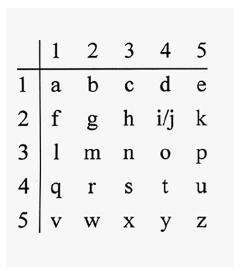ADFGX Cipher
█ JUDSON KNIGHT
The ADFGX cipher, sometimes referred to as the ADFGVX cipher, is one of the most famous codes in the entire history of cryptography. Introduced by the Germans in World War I, it is based on an ancient idea of associating letters with positions on a grid. Variations on the code have made communication possible across the walls of prison cells, and further intricacies added through the technique of transposition have made the code unbreakable without the aid of a computer.
Greek historian Polybius (fl.c. 200 B.C. ) introduced what became known as the Polybius square, a 5 x 5 grid that used the 24 letters of the Greek alphabet. Each letter had a unique position identifiable by a coordinate system that numbered the rows and columns. For example, A was one column to the right of the point of origin, and one row down, so its coordinate would be 11. In the English alphabet, two letters are combined in a single square so that the 26 letters fit into the 25-square grid. Supposing I and J are combined, then K would be at position 25—two rows down, and five squares over.
Over the centuries that followed, the Polybius square made possible a system of taps or knocks whereby prisoners could pass messages to one another across walls. Applied by groups ranging from Russian anarchists to American prisoners of war in Vietnam, the system has been described by writers as diverse as Arthur Koestler in Darkness at Noon, Aleksandr Solzhenitsyn in The Gulag

Archipelago, and Senator John S. McCain in Faith of Our Fathers. It has undergone countless variations based on the needs of the users—for example, a 6 x 6 grid for the 33 letters of the Russian alphabet—but the basic principle remains the same. According to the English-language grid described earlier, for instance, K would be rendered by two rapid knocks or taps, a short break, and then five rapid knocks or taps.
The ADFGX Cipher in World War I. The ADFGX cipher, developed by German army radio officer Fritz Nebel (1891–1967), made its appearance on March 5, 1918, when the Germans used it in a wireless transmission on the western front. Instead of the numerals 1 through 5 along a side of the Polybius square, Nebel's cipher applied the letters A, D, F, G, and X, which he chose because their equivalents in Morse code were so dissimilar that confusion was unlikely. (For example, A is one dot and two dashes, while D is one dash and two dots.) Three months later, on June 1, the German army added the letter V to make a sixth row and column. The 6 x 6 grid of the ADFGVX cipher allowed the inclusion of the 10 numerals from 0 to 9, like its predecessor.
The brilliance of the ADFGX cipher lay in the fact that, unlike ordinary codes, the frequency of letters such as E was not easy to recognize. Furthermore, the code could become even more challenging by applying a system of transposition. Suppose a message is written out in ADFGVX format—that is, as a series of two-letter combinations using just those six letters. That string of letters is then placed in a matrix under the letters of a chosen keyword, such as KAISER, which an army in wartime would typically change every day, Then the letters of the keyword are placed in alphabetical order—in this case, spelling AEIKRS, with the corresponding columns moved as well. After being transposed in this manner, the message is transcribed by reading down along each column, making it impossible for anyone who does not know the keyword to translate the message.
A modern computer would be capable of unscrambling such a transmission, even in a situation involving an unknown keyword, but the Allies in World War I were initially unable to break Nebel's code. However, French artillery captain Georges-Jean Painvin (1886–1980) did succeed in deciphering the code. Though his work was good only for a single day, it enabled the allied armies to counter the German offensive of June 9, 1918.
█ FURTHER READING:
BOOKS:
Haldane, Robert A. The Hidden War. New York: St. Martin's Press, 1978.
Konheim, Alan, G. Cryptography: A Primer. New York: Wiley, 1981.
Rosen, Kenneth H., and John G. Michaels. Handbook of Discrete and Combinatorial Mathematics. Boca Raton, FL: CRC Press, 2000.
Comment about this article, ask questions, or add new information about this topic: